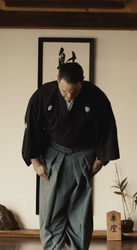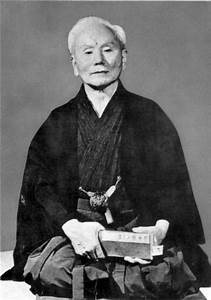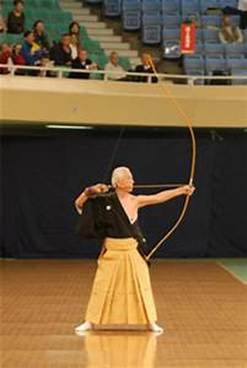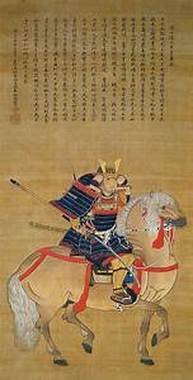
Dojo Rules and Etiquette
Our Dojo is one of the very few outside Japan that has been purified by a Shinto Priest. While the rules governing proper etiquette may vary from one dojo to the next, the underlying principles of sincerity, respect, and humility are universal and immutable. As such, all students must read and understand the following rules and etiquette before training. Students should learn and remember the rules that constitute proper dojo behavior that are essential to maintaining a safe and positive training environment.
Our dojo is much more than a "training hall”. It is a professional, structured environment where the spirit is forged through physical conditioning, self-discipline, and introspection. It is also called a Budojo (Bu=Budo) due to the various traditional arts learned here. The dojo has its own culture and it takes time to learn the proper procedures and protocol. You should ask your senior if you have any questions. Proper observance of the dojo protocol, group harmony, and etiquette are as much a part of your training as is learning techniques.
General
Our Dojo is one of the very few outside Japan that has been purified by a Shinto Priest. While the rules governing proper etiquette may vary from one dojo to the next, the underlying principles of sincerity, respect, and humility are universal and immutable. As such, all students must read and understand the following rules and etiquette before training. Students should learn and remember the rules that constitute proper dojo behavior that are essential to maintaining a safe and positive training environment.
Our dojo is much more than a "training hall”. It is a professional, structured environment where the spirit is forged through physical conditioning, self-discipline, and introspection. It is also called a Budojo (Bu=Budo) due to the various traditional arts learned here. The dojo has its own culture and it takes time to learn the proper procedures and protocol. You should ask your senior if you have any questions. Proper observance of the dojo protocol, group harmony, and etiquette are as much a part of your training as is learning techniques.
General
- The dojo building is located at the end of the paved driveway, past the main house. Students should park in the grassy area in front of the common building to the left of the driveway. Please refrain from parking in the driveway or in front of the main house
- The front gate will open 30 minutes before class begins. Be on time for class. If you happen to arrive late, sit quietly in Seiza or take a knee on the edge of the dojo space until the instructor grants permission to join practice. Gate automatically closes when class begins.
- Please bow in the direction of the kamidana when you step onto the dojo proper (that is when you step up onto the training floor). You should also bow when leaving the dojo proper
- No shoes in the dojo proper. Wear tabi or barefoot as appropriate. Shoes should be neatly arranged at the edge of the training floor or under the benches. Wipe you feet on the door mat. Students are recommended to flip flops or sandals (zori) while on property. You will be taking them on and off while going in and out of buildings.
- The trails, dock, or fields are generally off limits to students. The only exception will be during multi-day seminars. Students may use the restroom in the common building by the parking area and may relax at designated student lounge areas
- Avoid sitting on the floor with your back toward the kamidana. Do not lean against the walls or sit with your legs stretched out. Sit either in Seiza, cross-legged or take a knee
- Remove watches, rings, and all other jewelry before practice. Flat wedding bands are okay
- Phones and/or other electronic devices must be kept in your vehicle
- No video or photography unless specifically allowed by the instructor
- Do not bring food, gum, and beverages with you in the dojo
- Please keep your fingers and toe nails cut short
- We know that you like to catch up with your friends, please do not talk during class- catch up before or after class
- Do not engage in rough housing or needless contests of strength while on property
- Keep your uniform clean, in good shape, free of stains, major wrinkles, rips, and offensive odors. A neat and clean uniform shows respect for the Art and your practice mates as well as the instructor
- Carry out the directives of the instructor promptly. Do not keep the rest of the class waiting and never keep the instructor waiting
- Remember you are here to learn. An attitude of receptivity and humility is therefore advised
- Students should approach and correct others not abiding by the dojo rules, but this needs to be done in a courteous and non-demeaning manner after class
- Students should always remember that the dojo is located on private property and a private residence is located within. Therefore, preserve common sense, high moral standards, and respect at all times
- Dojo bedrooms can be used for out of town students in conjunction with training
- Senior students are are to make sure that Dojo protocols, process and procedures are taken care of in the absence of the Sensei
- Your outward demeanor is a reflection of your state of mind and inner being. If your demeanor is sloppy, inattentive, or overly casual then you are not in the right frame of mind to benefit from practice

Basics
Safety
The handling of swords (shinken), bows (Yumi) and arrows (Ya) in any capacity is potentially dangerous. Therefore, for the general safety and well-being of all participants, certain rules must be followed during training class. Every student should know and abide by these rules.
- In the rare case that the Sensei arrives late or leaves early, the class should be brought to attention and bow as a group
- Students must bow to the senior person on the floor. Always bow to any senior dan ranked students upon first meeting them
- Students shall bow to each other prior to mutual practice and upon completion of that exercise
- Absolutely no disrespect will be shown to instructors or fellow students
- Students should follow the instructions of their Sempai (the senior student)
- Respect your fellow students' experience in other Arts. Do not expound upon your experience to others during class, regardless of how it may relate to the techniques being taught
- Students shall refer to the head instructor as Sensei and Seniors as Sempai in the dojo and outside the dojo when the conversation relates to dojo and training matters. Otherwise they should be referred to by name
- Students should not leave class early without notifying the Sensei
- There is no talking in class unless you have been recognized by the Sensei by raising your hand or using the phrase "sumi-ma-sen Sensei” (excuse me teacher)
- During Iaido, Always place your sword on the rack, edge up, with the handle facing to the left as you face the rack. The upper spaces are reserved for higher ranks
- In Kyudo, your Bow should be placed right side up and not upside down
- Juniors should never walk in front of seated seniors without bowing and saying "sumi-ma-sen"
Safety
The handling of swords (shinken), bows (Yumi) and arrows (Ya) in any capacity is potentially dangerous. Therefore, for the general safety and well-being of all participants, certain rules must be followed during training class. Every student should know and abide by these rules.
- Always let the Sensei know if you are suffering from any physical disability, injury, or illness, or if you require special assistance before or after class
- Your health, your family, and your job come first. Come to class after you have fulfilled these important obligations
- Do not come to class when suffering from a contagious illness. Rest and come back to class when you have fully recovered
- Try your best, but do not overdo it. You can always take a break when needed. Just let the Sensei know
- When the instructor says "stop or ma-te" do exactly that, STOP! Don't move to where you think he wants you to be, don't make any kind of adjustments, simply stop all movement and stand there until he tells you to move
- NEVER walk directly behind someone training with a Sword or Bow. They cannot see you
- If your Sword slips out of the sheath (Saya), do not try to catch it. Step back and let it fall to the floor
- Check the condition of your Swords or Bow and Arrows before every class. Pay special attention to the mekugi pin in the handle of the sword, or the string (tsuru) of the bow and arrow knocks. If you have any doubts, ask your instructor
- Always be aware of where you are and where everyone else is while training. Develop this awareness and keep your proper distance
- Control your sword at all times, keep your thumb on the Tsuba when bowing and moving about
- Never make wild or careless motions with an unsheathed or sheathed sword or with Bows and Arrows
- Never place an unsheathed sword on the floor or on the rack
- When handing a sword out of its sheath to another person, hold the bottom of the handle with your little finger at the butt. The blade's cutting edge should face you
- When accepting a sword out of its saya, grasp the handle firmly at the guard with your left hand
- Wear your obi and hakama properly snug. Hakamas should never be overly long or short. They should just touch the tops of your feet or hang below the top of the tabi.
- Before cutting, check the mekugi peg in your sword's handle. If it is missing or loose, inform sensei immediately
- Be aware of whether or not you have bent your sword's blade during cutting. Allow your instructor to straighten it if needed. Never attempt to sheath a bent sword
- During sword cleaning, keep the sword blade pointed toward the wall and away from other students

Restrictions
- Do not come to class while intoxicated or on illicit drugs. Do not consume any alcohol before class
- Do not misuse any equipment in the dojo
- Do not use profanity, abusive, or racial language. Do not talk politics in the dojo
- Use a quiet voice in the dojo (except when leading the count)
- Do not talk to someone who is not in class or who is just watching
- Do not stand idle in class. This is your time to train by close observation (mi-tori keiko).
- All students must have their own iaito (metal practice sword) within 3-6 months of starting Iaido class
- All students must have their personal Shinken (cutting sword) or Yumi (Bow) and Arrows (Ya) within 6-12 months of starting tameshigiri or taking first shot
- Students may wear a plain white V neck undershirt under their do-gi top
- Your uniform should be put on after arrival to the dojo and then removed and properly folded before departing the dojo. Your uniform should always be mended and kept clean
- Dojo equipment is for use during class
- Please arrive at least a half an hour early to prepare targets or tatami and/or get changed so that training can begin on time
- If you will need extra stretching or warm-ups, do them before class begins
- The Sensei teaches class. Don’t offer advice to your fellow students
- Sempai will assist lower ranked grades in their training, but only upon the request of Sensei
- Whenever Sensei is explaining or demonstrating, all students should give him their full attention
- Never contradict or attempt to correct Sensei or Sempai during class---Discuss such matters with Sensei privately
- No interrupting while the instructor is teaching in class. If you have a question, wait until the instructor is done speaking and raise your hand
- Students should always question what they do not understand but answers are not debatable
- Students must not practice any technique that has not been formally taught to them by the Sensei
- Respect other styles but practice your own. Knowing "a little of this" and "a little of that" usually ends up being "a lot of nothing"
- You must have explicit permission from your Sensei to demonstrate any aspect of Iaido, Kyudo, or Karate outside the dojo. Students may not instruct others outside the dojo until they become an organizational certified instructor

Attitude
Our dojo is operated on a volunteer basis and is a Non-Profit. There are many ways you can serve your dojo, it is up to you to volunteer.
Being a member of a dojo is not like joining a health club. You are not “buying” some lessons and then going home. This means that it is the students’ responsibility to clean and maintain the dojo. Juniors and seniors must work together in the spirit of equality and “jita kyoei” (mutual welfare) when approaching such things. Before or after every class, the floor should be swept and the dressing rooms, common areas and mirrors cleaned as they are in Japan. These activities are age old matters of respecting the dojo space and leaving the dojo as clean, if not cleaner, than when you entered. Don’t wait for someone to ask you to help---it is part of your training to contribute to the space that is the dojo and the common areas. Look around: Is the trash full? Does the bathroom need cleaning? Find something that needs to be done and do it!
Whatever your dojo experience, all dojo members should gladly take part in everyday cleaning activities, regardless of rank or title. Remember this is your dojo. Just as with anyone’s outward personal bearing, your dojo and its appearance manifests the spirit of its members. A few minutes devoted to dojo cleanliness will go a long way in your future practice and positively contribute to the way others perceive the dojo.
Proper placement of your Katana or Yumi and Ya
Katana or Yumi / Ya should be placed in the appropriate rack or stand before class. Katana should be placed with the tsuka (handle) on the left and the edge facing upward. The sageo should be tied to secure the blade in the saya and not sloppily tied or overly long as to interfere with the other Katana. Katana or Yumi should be arranged in order of instructor/student seniority with the highest at the top of the rack for the Katana or the left side of the rack for the Yumi. If multiple sword racks or stands are used, the highest seniority is the sword rack/stand farthest from the main dojo entrance and closest to the shomen (front of the dojo). All Katana/Yumi should be properly placed in the sword rack/stand before class begins. Dojo loaner Katana/Yumi have lower seniority than student owned Yumi or Katana. If a student is unsure of where to place their Katana/Yumi, they should pick a lower position. Not leaving space for your senior is a breach of etiquette.
- As you advance, ego is a constant enemy. Remain humble
- Always accept correction positively and train with an open mind
- Always be courteous in demeanor, and helpful to juniors and to each other
- Always maintain a beginner's attitude. You can't learn if you think you already know it
- Pay close attention to what your instructor has to say at all times
- Come to class to learn. Students should also practice at home or during open practice times
- Never become angry or upset in the dojo
- It is far better to know one kata well than many kata poorly
- Never criticize other schools or styles of the martial arts
Our dojo is operated on a volunteer basis and is a Non-Profit. There are many ways you can serve your dojo, it is up to you to volunteer.
Being a member of a dojo is not like joining a health club. You are not “buying” some lessons and then going home. This means that it is the students’ responsibility to clean and maintain the dojo. Juniors and seniors must work together in the spirit of equality and “jita kyoei” (mutual welfare) when approaching such things. Before or after every class, the floor should be swept and the dressing rooms, common areas and mirrors cleaned as they are in Japan. These activities are age old matters of respecting the dojo space and leaving the dojo as clean, if not cleaner, than when you entered. Don’t wait for someone to ask you to help---it is part of your training to contribute to the space that is the dojo and the common areas. Look around: Is the trash full? Does the bathroom need cleaning? Find something that needs to be done and do it!
Whatever your dojo experience, all dojo members should gladly take part in everyday cleaning activities, regardless of rank or title. Remember this is your dojo. Just as with anyone’s outward personal bearing, your dojo and its appearance manifests the spirit of its members. A few minutes devoted to dojo cleanliness will go a long way in your future practice and positively contribute to the way others perceive the dojo.
- Never let a student with higher seniority work harder than you
- Never leave clothing or valuables of any type in the dojo. We will not be responsible for these articles if they are lost or stolen
- There are minimum time periods between grades. However, training for the minimum time period does not entitle the student to test. Many factors are involved in promotions such as attendance, technique, teaching ability, helpfulness, attitude, courtesy, effort, contributions to the Art, etc
- Never request to be tested or promoted. Your Sensei will let you know when you have reached the next level
- Students will be required to take a written exam to qualify for Shodan and up as well as attend Zen training Seminars
- Passing a rank test is not a formality and students should be prepared to fail
- Accept a promotion with a sense of increased responsibility to your fellow students and the Art
Proper placement of your Katana or Yumi and Ya
Katana or Yumi / Ya should be placed in the appropriate rack or stand before class. Katana should be placed with the tsuka (handle) on the left and the edge facing upward. The sageo should be tied to secure the blade in the saya and not sloppily tied or overly long as to interfere with the other Katana. Katana or Yumi should be arranged in order of instructor/student seniority with the highest at the top of the rack for the Katana or the left side of the rack for the Yumi. If multiple sword racks or stands are used, the highest seniority is the sword rack/stand farthest from the main dojo entrance and closest to the shomen (front of the dojo). All Katana/Yumi should be properly placed in the sword rack/stand before class begins. Dojo loaner Katana/Yumi have lower seniority than student owned Yumi or Katana. If a student is unsure of where to place their Katana/Yumi, they should pick a lower position. Not leaving space for your senior is a breach of etiquette.
